During his commentary with co-writer Drew Goddard on the Iron Man 3 Blu-Ray, director/writer Shane Black repeatedly jokes that while making the movie he would refer to the visual effects (VFX) shots as “cartoons.” This apparently annoyed some of the visual effects artists who put so much effort into making those “cartoons,” but he meant no offense. It was more that he had never made a film on the scale of Iron Man 3 before. There hadn’t been much of a need for VFX with the previous (and only other) film he’d directed, Kiss Kiss, Bang Bang (2005), and back when he broke into Hollywood as the guy who wrote Lethal Weapon (1986) VFX were still mostly about accentuating the practical. So, to him it simply helped to simplify things, and think of what the visual effects guys were doing as creating cartoons. In some cases, he knew that was an oversimplification; in other cases, well, that is pretty much entirely what they were doing if you define a cartoon as something which is entirely animated.
My sexagenarian step-father felt the same way when I recently showed him Guardians of the Galaxy for the first time. This is someone whose one constant reaction to most major recent film is, “Man, it’s simply amazing what they can do with computer graphics these days.” Well, there’s plenty of CGI in Guardians since two (Rocket and Groot) of its five primary characters are pretty much completely animated creations. However, while my stepdad appeared to enjoy the film he didn’t love it, simply saying afterward that there was a LOT of green screen acting (technically, it was a blue screen) going on.
There is perhaps even more of it than he realized. According to The Hollywood Reporter, nearly every shot in Guardians of the Galaxy has been enhanced with VFX, ”Filming Marvel’s superhero team involved 2,208 VFX shots — about 90 percent of all shots in the $170 million movie.”* It took 13 companies in 17 different locations to pull it off, with the effects house responsible for Alfonso Cauron’s groundbreaking Gravity tasked with creating Rocket and a completely different company responsible for Groot. There were stand-ins in green or blue suits on set for Rocket and Groot, with James Gunn’s own brother filling in as Rocket, but they were apparently used more for sightline purposes than any kind of motion-capture. So, although there was something there the effects people were pretty much completely animating over it. The majority of their work wasn’t just devoted to Rocket and Groot, though. “There also are several complex CG environments like Knowhere, a city inside a giant severed head with neighborhoods comprising 85,000 pieces such as towers, pillars and turbines.”
Of course, this isn’t Sky Captain and the World of Tomorrow or Sin City where the majority of the film is quite literally created with actors simply standing in front of green (or blue) screens. And while the work the visual effects geniuses put into bringing Rocket to screen is Oscar-caliber none of it would have mattered if Bradley Cooper hadn’t provided the voice that truly brought that character to life and James Gunn hadn’t given the character such great lines in the script.
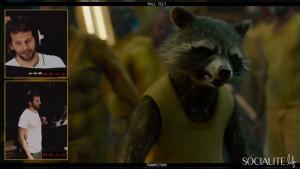
Cooper provided more than just his voice to Rocket. His audio recording sessions were taped so the animators could reference the facial expressions he made when he delivered his lines.
That being said, if you look at the special features on the Guardians of the Galaxy Blu-Ray James Gunn flat-out states the following:
The first thing that excited me about Guardians, before any story elements or anything else, was actually creating the visual look. The very first thing I did was I sat down and wrote a 19-page document that was called, “The Look of Guardians of the Galaxy.” It really was about creating a space opera that brought color back to these types of movies.
It should be noted that there was already a script in place, from Nicole Perlman, before Gunn came on board. So, it’s not like there was no script and no story, and here’s James Gunn writing a dossier about how the film should look. Plus, it seems fairly common with films of this scale for some directors to initially find their inspiration in what can be achieved visually before adjusting the story to fit the visuals. If you end up focusing too much on the visuals, though, your end result tends to look a lot like a Zack Snyder movie. Guardians of the Galaxy is more of a best case scenario. Given its setting and cast composition, the visuals are inevitably central to the film, but the work put into the script, casting the right actors, and getting the best performances on-set and through editing and giving the animators some human performance to reference, e.g., Gunn actually acted out certain scenes to help with how to animate Groot, means that you might just find yourself getting all verklempt near the end when [spoiler alert] Rocket cries over the apparent death of his best friend Groot [end spoiler alert]. You might completely forget that, as Shane Black would put, they’re both cartoon characters, not that we can’t cry at cartoons, though.
But how much longer will we forget that? Rocket and Groot are the extreme cutting edge of VFX, but Avengers: Age of Ultron is actually going to have more VFX shots (estimated to be around 3,000) than Guardians of the Galaxy, setting a record for any Marvel Studios release. The work they’re doing to bring Ultron to life, animating over James Spader’s performance, is probably going to look beyond awesome as will everything they’re doing with The Vision, Scarlet Witch’s reality-bending powers, Quicksilver’s super speed, etc. You can’t necessarily say that just because a film is going to have more CGI work than something else means that it will automatically look more impressive. If that were true, we wouldn’t be complaining about how green screen-y the The Hobbit: The Battle of Five Armies looks compared to the fight scenes in The Lord of the Rings trilogy. However, there’s CGI in something like 2013’s Man of Steel which already looks more fake to me than it did when the film came out, specifically sections of the Kryptonians’ fight against Superman in Smallville. Am I being too hard on it? Or is the technology really improving that quickly?
That’s the double-edged sword of doing Guardians of the Galaxy. It was only possible to do a film in which two-fifths of the main cast are CGI creations because technology had finally progressed that far, but unless CGI hits some sort of creative wall the technology will simply continue to progress thus robbing your film of any kind of timeless quality. We’re wowed now, but years from now we’ll look at it again and think how fake it looks. If you don’t think so I’d simply ask when was the last time you watched Gollum in The Two Towers? If it’s been a while go watch it again:

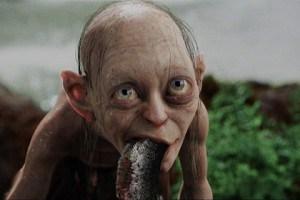 Then watch Gollum in Hobbit: Unexpected Journey.
Then watch Gollum in Hobbit: Unexpected Journey.
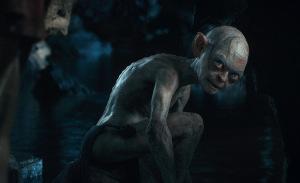
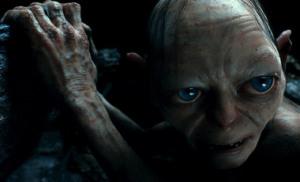 The older version of Gollum, while still enjoyable, is starting to show its age.
The older version of Gollum, while still enjoyable, is starting to show its age.
It’s all in the eye of the beholder, and I am certainly no expert when it comes to the actual creation and critical evaluation of VFX. However, I am a movie fan, and ever since I was wowed by the something like the T-1000 in Terminator 2 I’ve been set-up to consistently go back to films like that and inevitably think, “Oh, it looks so fake now.” That’s why I wonder how well Guardians of the Galaxy will age, and it also helps me to really appreciate Christopher Nolan’s determination to ground everything in some kind of practical effect, using far less green screen on Interstellar – a film largely set in space – than you’d guess. That doesn’t necessarily mean that Interstellar will definitely age, in terms of how it looks, better than Guardians. It’s not like they weren’t also mixing the practical with the CGI on Guardians too; it’s just that they had way more CGI.
By complete coincidence, as all of this was running around my head this morning I came across Independence Day on TV. It was the very end of the movie. Will Smith and Jeff Goldblum had already done their thing, Randy Quaid kamikaze’d his way to oblivion, and Bill Pullman mostly challenged us to remember that he’s not Bill Paxton. Good times. The world has been saved, and the heroes rejoice, Smith carrying his girlfriend’s son to watch the alien ship exploding, triumphantly delivering his line about showing him fireworks on the 4th of July. It’s a rah-rah moment in a film filled with them, a good note to go out on, yet when viewed now all I could see was how supremely fake it looked:
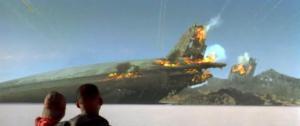 Is that Guardians of the Galaxy’s inevitable fate? And is Peter Jackson right? Has Hollywood become too dependent on technology, even if he comes off as a hypocrit for saying so considering he’s the guy who made King Kong, Lord of the Rings, and The Hobbit? Or does none of this matter because those are tomorrow’s problems; why try to find the negative in something as positive and fun as Guardians of the Galaxy? Let me know what you think in the comments.
Is that Guardians of the Galaxy’s inevitable fate? And is Peter Jackson right? Has Hollywood become too dependent on technology, even if he comes off as a hypocrit for saying so considering he’s the guy who made King Kong, Lord of the Rings, and The Hobbit? Or does none of this matter because those are tomorrow’s problems; why try to find the negative in something as positive and fun as Guardians of the Galaxy? Let me know what you think in the comments.
*Oddly, THR previously reported Guardians total number of VFX shots was considerably larger, more like 2,750.

